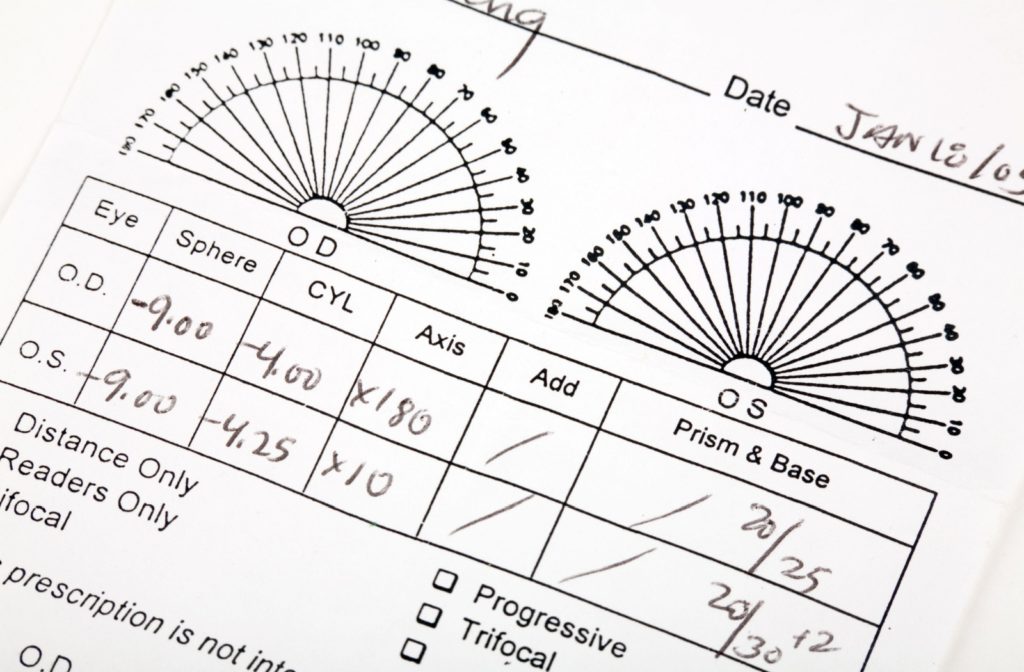If you’ve ever looked at the numbers on your eyeglass prescription, you may be a bit confused about what they mean. What is a “bad” prescription? Is a ‘+’ better than a ‘-’? Understanding your eyeglass prescription can feel like deciphering a secret code, but it’s simply a set of instructions for the person making your lenses.
In general, a higher number means a “bad” prescription, while the plus (+) and minus (-) symbols refer to what kind of refractive error your glasses must correct. After your next eye exam, take a glance at your prescription and consider what it says about your vision.
What Is an Eyeglasses Prescription?
An eyeglasses prescription is a detailed measurement of how lenses should be crafted to correct your vision. It tells the optician precisely how much correction your eyes need to see clearly. Without this prescription, choosing the right lenses would be a guessing game.
While it may be overwhelming at first, your prescription isn’t just a bunch of random numbers and letters. Each part has a specific meaning:
- SPH (Sphere): Indicates the lens power needed to correct nearsightedness or farsightedness.
- CYL (Cylinder): Measures the lens power needed to correct astigmatism, which is an irregularly shaped cornea or lens.
- Axis: Specifies the orientation of astigmatism correction in degrees, ranging from 0 to 180.
How to Read Your Eyeglasses Prescription
Reading your eyeglasses prescription might seem complex, but it’s simpler than you think. Grab one if you have it. The first thing you may notice is two acronyms, O.D. and O.S. These are the Latin terms for your eyes. O.D. (Oculus Dexter) refers to the right eye, and O.S. (Oculus Sinister) refers to the left eye.
Now you can move on to the rest of the prescription with this step-by-step guide:
- Identify the SPH (Sphere) number. A minus sign (-) indicates nearsightedness, while a plus sign (+) indicates farsightedness.
- Look for the CYL (Cylinder) value, which shows the degree of astigmatism correction needed.
- Check the Axis, which ranges from 0 to 180 degrees, indicating where the astigmatism is on your cornea.
- Add-ons like ADD (additional magnifying power for reading, such as in bifocals) or Prism (used to correct double vision) might also be present.
Other common terms you may notice are:
- Plano: This means zero correction or no need for lens power.
- Prism and Base: Used to correct eye alignment issues.
Understanding the Numbers
Imagine your prescription reads:
- O.D. -2.00 SPH -1.00 CYL 180 Axis
- O.S. -1.50 SPH -0.50 CYL 90 Axis
For the right eye (O.D.), you need 2.00 diopters of correction for nearsightedness, 1.00 diopters for astigmatism, and the astigmatism correction is oriented at 180 degrees. For the left eye (O.S.), you need 1.50 diopters for nearsightedness, 0.50 diopters for astigmatism, oriented at 90 degrees.
One of the most common misconceptions is that higher numbers in your prescription automatically translate to “worse” vision. While it is true that higher SPH or CYL values indicate a greater degree of nearsightedness, farsightedness, or astigmatism, this does not necessarily equate to poor overall eye health.
Eye health encompasses more than just refractive errors—it includes factors like eye pressure, retina health, and the condition of the cornea, among others. Even someone with “perfect vision” can still have vision issues.

When to Update Your Prescription
Usually, a prescription is valid for one to two years, but this can change based on factors like your age, eye health, and risk of eye conditions.
Kids and teens might need more frequent updates since their vision can change quickly, so they should visit an optometrist annually. Adults aged 18 to 64 with stable vision generally don’t need updates as often but should still have an eye exam at least every 2 years.
Regular eye exams aren’t just for ensuring your prescription is current—they’re also important for keeping your eyes healthy. These exams can uncover early signs of eye conditions like glaucoma, cataracts, and macular degeneration, which are easier to treat if found promptly.
Always talk to your optometrist to figure out how often you should update your prescription and recognize the signs that may indicate you need a new prescription, such as:
- Frequent headaches
- Squinting or eye strain when reading or using a computer
- Blurred vision
- Difficulty focusing on objects
Eye exams can also reveal general health issues such as diabetes and high blood pressure, making them a key part of your overall health routine.
Knowledge Is Power in Eye Care
Understanding your eyeglass prescription is empowering and helps you make informed decisions about your eyewear. If your family hasn’t had their eyes checked recently, now is the perfect time to schedule an eye exam. Take control of your eye health and enjoy the clarity that comes with it.
Book an eye exam with Total Vision Golden Hills today and experience the difference in your vision care!



